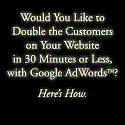

4 Ways to Sell More Products Online
This is a guest contribution from Rosie Scott of The New Craft Society.
As we discussed recently in this post, making money via blogging is far more than fanciful thinking; for an increasing number of dedicated bloggers, it’s a rewarding reality. But there’s a difference between, “Hey mom! I made 30 cents this month using nothing but my typing fingers!” and, you know, actually making a living. Whether you generate sales through coaching, services, eBooks, physical products or any of the many other ways bloggers can pull a profit, selling more products online means thinking more like a business. Don’t worry – it’s not as intimidating as it might sound, and you won’t lose suddenly turn into a heartless corporate shill.
1. Optimize Your Website for Sales
It may sound obvious, but if you’re going to sell products through your blog, you’ve got to get it primed for sales. This is intuitively done on business websites, where the focus is all on the product and there’s all of one section devoted to a blog. It can be a little less natural, however, when blogs are the central focus. Here’s how to get it right.
Make a separate tab for your store. Each product or service you’re selling should have its own, dedicated page. If it’s a digital product, it should be downloadable in as few clicks as possible. If you’re using a shopping cart, that should also be easily accessible, with few to no barriers to purchase, like long contact or sign up forms.
Don’t fear the long-form sales page. When in doubt, it’s better to give more details than too few. Don’t skimp on shipping policies, product details, contact info, technical specs, product FAQs – anything you can think of that a customer might need to know. You can separate this easily with on page grids or columns. However, even a long form sales pitch can be highly effective, as long as it tells a great story (and as a blogger, isn’t that what you do?). Take a look how writer and writing coach Alexandra Franzen does it for her I <3 Email course. That is one long sales page, but it’s broken up well with catchy headlines, all the essential details about the course, bullets, testimonials, and at one point, an easy sign up, but it’s off the site now as the course has sold out. The point is, if you’ve got the details, make ‘em known.
Take excellent photos. Customers may like the convenience of online shopping, but there’s just nothing quite like holding a product in one’s hands to really get a sense of it. Photos go a long way towards mitigating that problem, allowing customers a much more in-depth look. As such, it makes sense to invest in a good photographer to take clear, high quality product photos, from just about every angle you can imagine.
Make sharing easy. These days, having a social bar on a sales page is essential, so that customers can easily share products or services they think are great on their favorite social networks. Whether it’s at the bottom, on the side, or several places throughout the page, you’ll do best when sharing is one-click easy.
Encourage feedback. Reviews are by and large one of the biggest deciding factors for potential customers. In this social age, they’re also a form of social proofing (i.e. if that personable looking guy thinks it’s good, it probably is). Three weeks after purchase, email your customers directly to ask for a review, and feature the good ones prominently on a testimonial page.
Consider a third-party selling platform. Managing shopping cart software on your own can be difficult, not to mention handling payments. It can be a lot easier to simply integrate a third-party platform like Shopify into your site, as you’ll get to retain the look and feel of your site while Shopify does all of the backend heavy lifting. Alternatively, for certain kinds of bloggers, sending followers to a different site altogether can be an even better option, especially if you want to keep your blog from getting to sales-centric, and it makes things much simpler from a design standpoint. A good guide to Etsy, for example, will get you quickly set up to sell on that particular site without any of the work you’d have to do to fit a store onto your personal blog. Doing so will also enter you into a wider pool of sellers that customers already trust, thereby broadening your reach and doubling your efforts.
2. Up Your Content Strategy
As a blogger, you’ve already got somewhat of a built-in strategy; content is, after all, kind of what you do. But if you really want to up your sales, you’ve got to get organized about just what you’re posting, when you’re posting it, who you’re promoting it to and how you’re doing so.
Do some sleuthing to determine what readers want. Maybe you’ve already furrowed down into a profitable niche, or maybe you’re still just sniffing the ground to figure out where the best scents lead. Either way, it’s always worth doing a little detective work to determine just what your readers (or potential readers) want to read – all the better if that just so happens to tie into a service or product you’ve got for sale. To do this, take a look at some of the keywords that are bringing people to your blog, and be on the hunt for any questions you have yet to answer. Comments on both your blog and on other blogs within your niche are also a great place to look for this, as are trending topics on places like Google+ or Twitter. Or, hey, here’s something novel: just get on social media and ask your readers all about their deepest questions within your niche. Boom: you’ve got a wealth of posts, ready to go.
Change up your format. Sure, how-to blogposts and scintillating written stories are great to read. But why not change it up a bit from time to time? Videos, infographics, and especially contests and giveaways are a great way to engage readers, and they each provide plenty of room for your unique personality. Launching a new doggy daycare service on your pup-centric blog? (See, I can’t stop with the dog thing!). Have your readers send in cute photos of their pups for a chance to win free services. The more varied and creative you get with it, the more readers you’ll get sharing your work, the more products you’ll ultimately sell.
Get serious about an editorial calendar. In the old days, you could get away with blogging about whatever interested in you from post to post. When you’re trying to sell products and services, getting organized with an editorial calendar is key. This way, you can better vary your content and spread out your product marketing, so it’s not all “buy, buy, buy!” one week and random blogposts the next. In fact, depending on your product, you’ll still want to plan so that you’re primarily focusing on your regular blogging, with your promotions more widely staggered.
Organize your audience into categories. Readers who follow you on Facebook aren’t necessarily drawn to you for the same reasons as Twitter followers, nor do they expect to engage with your blog or products in the same manner in each place. Take some time to research your followers on each social media platform, and to curate posts and shares, whether promotional or otherwise, that really make sense for each one. Even if the ultimate message is the same, it should be communicated differently on each platform. Taking the time to tailor your social media messages will make the much more shareable on each one.
3. Engage More With Your Followers
This may be something you already do, but if not, it’s time to start engaging at a much deeper level and more comprehensively with your potential and current followers. In one respect, it makes sense again to think of yourself like a business with need for customer service representatives; if someone comments on your blog or tweets a complaint about a product, they deserve a response, even if it’s just a “Thanks!” or a retweet. (Caveat: You still retain a blogger’s right to ignore trolls).
However, it’s important not to take the customer service representative idea too far and let yourself turn into an automaton. Big businesses, after all, are increasingly trying to sound just as personable as bloggers, so you’ve already got a real advantage in that department. Which is to say: respond in your characteristic tone of voice, using the full force of your personality. Just be polite and encouraging wherever you can.
And hey, if you’ve already got a loyal following, use it! As you promote your posts and products on different platforms, reach out to followers directly with @mentions, as long as you think they’d truly be interested in what you have to say. Pose discussion questions, or host a Google Hangout where you can talk issues of the day or simply, well, hangout. The greater the response your followers get from you, the more they’ll feel like they know you and that you’re on the same team, the more willing to buy they’ll be.
4. Cross Sell
On the other end of the corporate vs. personable blogger spectrum, there’s the essential art of cross selling. Hey, if the big guys benefit from it everyday, why shouldn’t you? If it’s done right, cross selling is really just the process of giving your customers even more of what they need, not just randomly throwing more advertising at them. Think of what happens when you book a flight on Kayak. It’s not like when you check out, the site offers you low, low, LOW prices on used cars or trucks, for a limited time only! Rather, the deals they offer are on hotels or car rentals at your destination. You know, stuff you’re probably going to be booking anyway.
Just how you cross sell will depend entirely on the kind of product or service, and you will be the best person to determine just what matches well with what. Cross selling might be done, as we just saw in the Kayak example, at the moment of checkout. It can also happen in the form of a bundle, like when Amazon offers you a deal or sometimes just the convenience of packaging three similar items in one. It can come in the form of an incentive, or in the form of data, by suggesting similar products or service that other people bought in conjunction with the one the buyer added to their cart. It can also come in the form of expert recommendations, or in a 2-for-1 type of offer.
Don’t have anything to cross sell yet? That’s fine. You’ll still want to draw the purchaser further into your brand by suggesting they sign up for your newsletter or connect with you via social media as they check out. The goal here is to think beyond the single sale.
The Takeaway
Chances are, you came to blogging so that you could talk about your passions, and you dreamed, too, of that passion supporting you full-time. Well, in order for that to happen, you’ve got to sell products or services, and doing that requires a good dose of business savvy. With a little education and experimentation, I know it’s doable for you. So get going, and have fun!
Originally at: Blog Tips at ProBlogger
Facebook comments:
No Comments »
No comments yet.
RSS feed for comments on this post. TrackBack URL
Leave a comment















